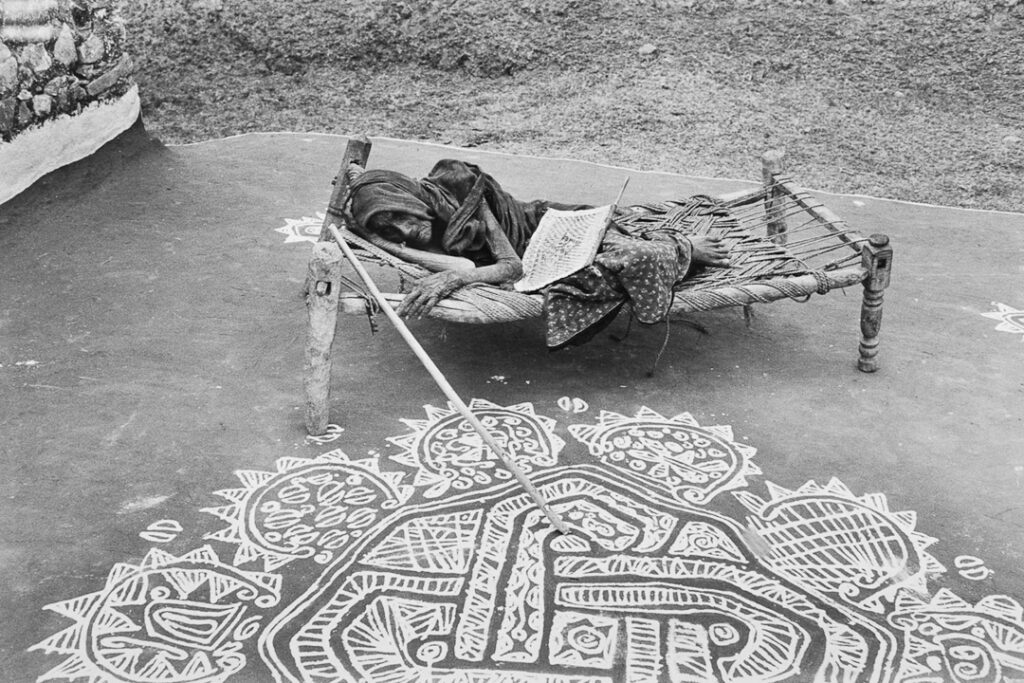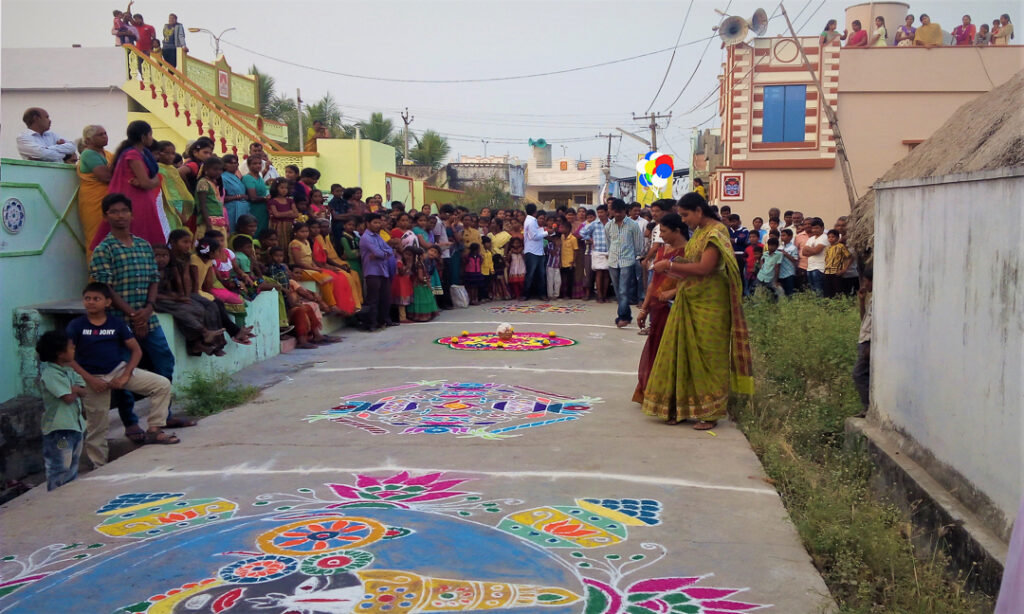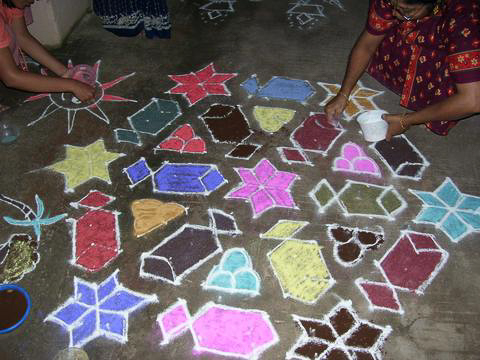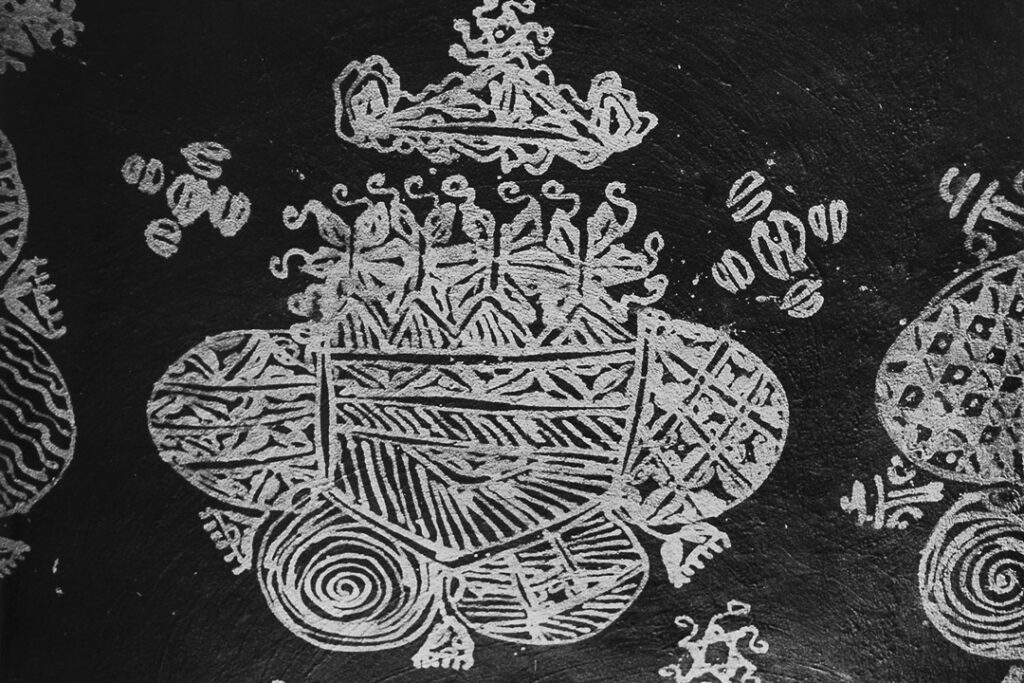Alolika De from the MAP Academy presents the rich and constantly evolving variety of traditions involving threshold decoration in India.
It is the morning of Diwali, the Hindu festival of lights, and households in Mumbai, India are bustling with activity, preparing for the arrival of Lakshmi, the goddess of wealth.
In one such home, the married woman of the household, having washed, heads to the space just outside the entrance door with a small pot of water. She sprinkles the water over the threshold in a symbolic act of purification, and then carefully and deftly starts drawing an elaborate pattern on the floor with a white powder. Heavy with centuries-old knowledge and tradition, the powder slips between the fingers of her right hand to create an outer perimeter of flower petals, followed by delicate swirls in the inner circle, and finally, a tiny flower at the centre. The intricate piece of art still unfinished, she now reaches for some brightly coloured powders — pink, green, yellow and red — to fill in her creation. Her threshold floor drawing — the rangoli — is finally complete.
Simultaneously, all across South Asia, tens of thousands of women, predominantly Hindu, step out to purify their thresholds and proceed to create such patterns there — some consulting pattern books, others drawing freehand. This is, after all, the morning of a festival, and the auspicious rangoli will bring good fortune to their homes.
Made across the length and breadth of the country, these drawings are known by different names—known as rangoli in Maharashtra and neighbouring Gujarat and Karnataka, they are called muggu in Andhra Pradesh and Telangana, and chowkpurana in Punjab, Haryana, Himachal Pradesh, Madhya Pradesh and Uttar Pradesh. Whilst the form carries a variety of meanings depending on its regional history, it is bound by the common canvas of the building’s threshold. Whereas in northern India the drawings are reserved for the mornings of festivals and other auspicious events such as weddings and birthdays, in southern India they are commonly made twice a day, marking the rising and setting of the sun, every day of the year.
A ubiquitous presence in rural, as well as urban South Asia, threshold floor drawings, make for essentially impermanent art, and one that is often without an audience — except, perhaps, a stray dog or a curious child who might glance that way.
Marking and dissolving boundaries: Home, art and society in threshold floor drawings
The threshold, along with the balcony and the courtyard, is an ambivalent part of domestic architecture. It is neither the exterior nor the interior, but is instead a connection between the house and its surroundings — the neighbourhood, village or city. Threshold drawings therefore represent an extension or continuation of the house onto the street—symbols of a well-functioning household, inviting curiosity and appreciation. Over the course of the day, the street lays claim to the house through these drawings—transient, distracted audiences spare an admiring glance; children’s bicycles leave tyre tracks across the white patterns; footprints blur the lines; and the wind carries away the powders. The floor drawings are pristine for the briefest hours before they take on new lives and forms—always in conversation with the elements that populate the busy “outside”.
Each day, the drawing might be disturbed or wiped clean, and there are no attempts towards preservation, for a new one appears the very next day. Nor are these drawings for domestic spaces alone. They mark the thresholds of all manner of buildings—shops, offices, colleges, government buildings, temples, shopping malls, and even unexpected places such as petrol pumps.
- Woman drawing Muggulu, Andhra Pradesh, India, c.1983, Silver gelatin print, 25.7 x 36.3 cm. Image courtesy of the Museum of Art and Photography, Bengaluru.
- An Old Woman Having her Afternoon Nap Next to a Mandana, Rajasthan; Jyoti Bhatt; c. 1981; Silver gelatin print; 19.7 x 29.8 cm; Museum of Art & Photography (MAP), Bengaluru
This constant act of making and unmaking is supported by the relentless and often unquestioning labour of women. In her essay ‘The Home in the World: Women, Threshold Design and Performative Relations in Contemporary Tamil Nadu, South India’, the scholar Renate Dohmen recounts her conversation with Tamil women. When asked why they drew the kolam, as it is called here, the women, after much thought, attributed it either to custom or to the wish to ensure the happiness of their children. Thus, these drawings too become part of the woman’s often unacknowledged domestic labour. Passed down generations, mostly among women — with no written or pictorial record until the eighteenth century — the knowledge and practice of threshold drawings, when sieved through time, leaves behind only repeated movements and uncertain significations. There exist thousands of patterns, and each successive generation interprets, adds to and changes a pattern, or invents a new one entirely, growing this corpus of shared, implicit knowledge.
Drawing from nature or from religious iconography, these varied patterns serve both decorative and symbolic purposes, and the creator can choose the elements she wants to adopt. Some floor drawings are minuscule while others are so large that they defy the threshold and spread out onto the street; some patterns are geometric, some floral, and others a unique invention of the creative mind; some signify joyous occasions, others the beginning of a new day or a new season. Whilst most occupy the threshold, some can be found in the kitchen, near the domestic shrine and even on walls.
- Pulli Kolam, Ramdhaya, c. 2012. Image courtesy of Wikimedia Commons
- Peacock Kolam, Priyadarshini Mohanraj, c. 2022. Image courtesy of Wikimedia Commons
Despite their rich characteristics and complexities, threshold floor drawings have never been formally considered ‘art’. Their ubiquity and their association with the sphere of the domestic and the feminine have affected their consideration as street art, and perhaps even their acceptance as a recognised visual art practice. However, they remain as much a part of public spaces as murals, graffitied walls and trains, spray-painted and stencilled forms, stickers and pasted bills. These impermanent drawings are, in fact, simultaneously performance art, public art and street art.
Scholars have speculated that the tradition of threshold floor drawings was developed in pre-Aryan times to appease nature deities in order to secure food and livelihood. However, the practice was appropriated at a later point by Hinduism and its inbuilt caste hierarchy and consequently infused with notions of purity and pollution. In his essay ‘The History of the Rangavalli Art’, scholar P. K. Gode details how Brahmins — the uppermost, traditionally priestly caste — after purifying themselves by bathing, cleanse the pollution of the threshold by first sprinkling it with a mixture of cow dung and water, and then drawing the rangoli, demarcating the area of ‘Brahmanical purity’. The rangoli was believed to resist the caste pollution brought about by the heterogeneous composition of a village and also marked the border that people from the lower castes could not cross. Despite such associations, however, the practice of making such threshold drawings today is not the reserve of the upper castes alone.
Connecting the dots: Parallel traditions across the subcontinent
For the casual viewer looking at the kaleidoscope of threshold floor drawings in India, it might be difficult to read the symbols pictured in them or identify their regional specificity. The muggu of Andhra Pradesh and Telangana comprises a labyrinthine pattern of straight lines, curves with knots, geometric designs, or a combination of these, Built over a framework of dots that is plotted using white rice or chalk powder. The woman of the household draws it at the crack of dawn, inviting the Sun god to imbue the colours with his divine powers and secure the house against evil. The drawing’s intricacy and novelty are contingent on the importance of the day and the time available to the woman.
- Traditional Rice Flour Kolam, SKsiddhartthan, c. 2017. Image courtesy of Wikimedia Commons
- Kolam Art, Jean-Pierre Dalbéra, c. 2001. Image courtesy of Wikimedia Commons
The kolam of Tamil Nadu is similar to the muggu. It is created in the morning, and sometimes in the evening too, using ornate looping patterns over a dotted grid. During the harvest festival of Pongal it takes an extravagant form, as women participate in an informal competition to create the most beautiful and intricate kolam, eager to receive the blessings of the goddess Lakshmi for a successful harvest and for the next farming season. Here the humble white powder is replaced or complemented by colourful synthetic powders and thick layers of scented flower petals. One of the recurring motifs is the lotus — the seat of Lakshmi in Hindu iconography, it also exemplifies the tenacity of goodness and beauty as the plant grows in murky waters. These traditional motifs blend with unique artistic self-expression in formal competitions, such as the Mylapore festival, which takes place every year in the Mylapore neighbourhood of Chennai. Gender, age and religious barriers are relaxed as men and women of all ages and various religions enthusiastically decorate the streets with large, resplendent designs, infusing them with village scenes, images of the god Shiva, as well as innovative motifs such as clocks with butterfly wings for hands.
- Rangoli Competition, Avinashpothenini c. 2016. Image courtesy of Wikimedia Commons
- Pongal Rangoli, Raji Srinivas, c. 2007. Image courtesy of Wikimedia Commons
Threshold floor drawing traditions have existed in the Indian subcontinent both within and outside of the Hindu religious and caste framework. Take, for example, the alpana. This tradition is thought to have roots in the culture of the Adivasis, or indigenous communities, of the region. It is practised by the Santhal people in India and Bangladesh, who lie outside the Hindu caste system and are predominantly dependent on forest produce and crop cultivation. Mixing rice powder and water, they use this white paste to adorn thresholds and the walls of their house with simple geometric designs and motifs from nature such as the lotus, the Sun, creepers, fish and elephants. Dedicated to the deity Marang Buru, or ‘Great Mountain’, this pantheistic alpana forms part of the Santhals’ prayers invoking the forces of nature in an expression of gratitude and a wish for a good harvest.
In the same region, the brata alpana, in contrast, is a caste-based Hindu tradition. A brata is a vow to fast taken by Bengali Hindu women for the good fortune of the household. It involves various rituals, among which is the drawing of the alpana. In his essay “Symbols of Good Fortune: An Analysis of Alpanas as Sacred Images that Represent Auspiciousness”, Joseph Heizman asserts that the alpana is a way for Hindu women to express themselves, fulfil their dharma, or religious duty, and pray for material, familial and spiritual wellbeing and prosperity. The design of the alpana depends on the type of brata undertaken, and it may contain symbols or illustrate mythical stories. The Lakshmi brata, performed just before a wedding to wish for a prosperous marriage, involves the making of an alpana consisting of square borders laced with vines representing fertility. Within this perimeter lie jewellery motifs such as bangles, necklaces and earrings, which signify the desire for material wealth. At the bottom is drawn a pair of feet representing the footprints of Lakshmi who is to descend on this alpana and turn it ‘magical’. Compared to the relatively austere alpana drawn by the Santhal people, the brata alpana can take more elaborate and intricate forms.
Across the border, in Bangladesh, the alpana takes a more secular tone and is drawn on events like the International Mother Language Day, Victory Day and Independence Day, using the national flag colours of green and red in addition to white.
- A Pongal Kolam, Thamizhpparithi Maari, c. 2012. Image courtesy of Wikimedia Commons
- Bright big flower rangoli kolam, Durga B, c. 2023. Image courtesy of Wikimedia Commons
Back in India, to the north, Punjab’s phulkari chowk explodes in a burst of colours. Part of a broader style of threshold drawing called chowkpurana—chowk translating to “square” and purana “to fill”—it quite literally entails filling in a square space. Phulkari chowk is made by Punjabi women during weddings and festivals using flour and coloured powders, and employs motifs from the region’s phulkari, or “flower work”, embroidery within the square. The floral motifs of bright marigolds, jasmines and lotuses are intended, both in the embroidery and the floor drawing, to dispel misfortune.
- Mandana Drawn by a Mina Woman; Jyoti Bhatt; Late 20th century; Silver gelatin print; 28.6 x 19.4 cm; Museum of Art & Photography (MAP), Bengaluru
- A Common Floor Diagram (Mandana) Made by Women from the Meena Community; Jyoti Bhatt; c. 1972; Silver gelatin print; 20.1 x 27.9 cm; Museum of Art & Photography (MAP), Bengaluru
In western India, a form of floor drawing known as mandana is practised in the states of Rajasthan and Gujarat. This is done exclusively by the women of the Adivasi Meena community, using red clay and chalk. These drawings, comprising concentric patterns made on walls, floors, prayer-rooms and kitchens, mark the celebration of festivals.
Why, one might wonder, are such drawing practices prevalent across the breadth of the Indian subcontinent? Why are they especially important to the Hindu religion? The answer could lie in the philosophical idea of alamkara, or decoration and ornamentation, as being auspicious. Whilst an abundance of decoration is most obviously visible when we look at medieval art and architecture from the Indian subcontinent or even classical poetry and prose from the region, ornamentation also suffuses daily life—and such floor drawings form one mode of invoking the power of alamkara. Through these drawings, made so laboriously, often daily, women don’t simply beautify their homes — they create talismanic protections that keep their space and their families safe, prosperous and blessed.
Stepping out: Floor drawings reimagined
While these threshold floor drawings are clearly filled with significance, they are also time-consuming and ephemeral. It is not surprising that modernity has offered a solution—quicker and more permanent versions of these drawings have been enabled by innovations such as synthetic dyes, design stencils, and rangoli stickers. These interventions have not only increased the longevity of threshold floor drawings—thereby fundamentally altering their impermanence and fragility—but have also reduced the time and labour needed in making them, offering women the opportunity to enjoy other aspects of the festivities and gain a little more time in the day. Such inventions have also made the art of floor drawings more accessible, allowing eager artists of all ages and skills to comfortably participate in this ritual. Finally, modern floor drawings also serve secular purposes—no longer simply a medium to invoke the gods, they become a versatile canvas for social or political statements, such as to register popular protest against oppressive laws and injustices. A recent example is the kolams drawn in Tamil Nadu to protest the government’s discriminatory Citizenship (Amendment) Act, which offers citizenship only to non-Muslim migrants, from selected countries, who arrived in India before 2015.
Traditional floor drawings have also become unique mediums of expression for artists, who use the ephemeral qualities of this form in performative ways to generate affective sensations in their audience, rather than to have their work preserved for posterity. Onlookers participate in the collective despair that accompanies the destruction of such drawings by the artists themselves — but the beauty of these floor drawings also lies in the promise of their reappearance—across the threshold, on another day, and in a new form.
About Alolika
 Alolika (she/they) holds a bachelor’s and a master’s degree in English Literature from St. Stephen’s College, Delhi University. Her research interests include visual art, necropolitics, affect studies and violence. At the MAP Academy, she oversees the editorial processes for Tangents and Instagram. The MAP Academy is a non-profit, open-access educational platform committed to building equitable resources for the study of art histories from South Asia. Through its freely available digital offerings — Encyclopedia of Art, Online Courses, and Stories — it encourages knowledge-building and engagement with the visual arts of the region. Email alolika.de@map-india.org
Alolika (she/they) holds a bachelor’s and a master’s degree in English Literature from St. Stephen’s College, Delhi University. Her research interests include visual art, necropolitics, affect studies and violence. At the MAP Academy, she oversees the editorial processes for Tangents and Instagram. The MAP Academy is a non-profit, open-access educational platform committed to building equitable resources for the study of art histories from South Asia. Through its freely available digital offerings — Encyclopedia of Art, Online Courses, and Stories — it encourages knowledge-building and engagement with the visual arts of the region. Email alolika.de@map-india.org
Bibliography
- Dohmen, Renate. “The Home in the World: Women, Threshold Designs and Performative Relations in Contemporary Tamil Nadu, South India.” Cultural Geographies 11, no. 1 (2004): 7–25. http://www.jstor.org/stable/44250953.
- Dutta, Swarup. “The Mystery of Indian Floor Paintings.” Chitrolekha Journal 1, no. 1 (2011). https://chitrolekha.com/the-mystery-of-indian-floor-paintings/
- Gode, P. K. “History of the Rangavalli (Rāṅgoḷī) Art — Between c. A. D. 50 and 1900.” Annals of the Bhandarkar Oriental Research Institute 28, no. 3/4 (1947): 226–46. http://www.jstor.org/stable/44028067.
- Heizman, Joseph. “Symbols of Good Fortune: An Analysis of Alpanas as Sacred Images that Represent Auspiciousness.” (2011) Outstanding Honors Theses. 33. https://digitalcommons.usf.edu/honors_et/33.
- Islam, Monirul Alom, Zahangir. “The Aappeal of Aalpana is Uuniversal… Monirul Islam.” Interview by Zahangir Alom., The Daily Star. February 21, 2015. Accessed January 30, 2024. https://www.thedailystar.net/arts-entertainment/interview/the-appeal-alpana-universal-monirul-islam-3038.
- Kilambi, Jyotsna S. “Toward an Understanding of the Muggu: Threshold Drawings in Hyderabad.” RES: Anthropology and Aesthetics, no. 10 (1985): 71–102. http://www.jstor.org/stable/20166735.
- Nagarajan, Vijaya Rettakudi. “Threshold Designs, Forehead Dots, and Menstruation Rituals: Exploring Time and Space in Tamil Kolams,” in Women’s Lives, Women’s Rituals in the Hindu Tradition, edited by Tracy Pintchman. (New York, 2007; online edn, Oxford Academic, May 1, 2007) Accessed January 28, 2024. https://doi.org/10.1093/acprof:oso/9780195177060.003.0006.
- MAP Academy Encyclopedia of Art. “Mandana.” Article. April 21, 2022. https://mapacademy.io/article/mandana/.
- MAP Academy Encyclopedia of Art. “Muggu.” Article. April 21, 2022. https://mapacademy.io/article/muggu/.
- MAP Academy Encyclopedia of Art. “Kolam.” Glossary. https://mapacademy.io/glossary/kolam/.
- MAP Academy Encyclopedia of Art. “Alpona.” Glossary. https://mapacademy.io/glossary/alpona/.
- MAP Academy Encyclopedia of Art. “Phulkari.” Article. April 21, 2022. https://mapacademy.io/article/phulkari/.
- Ministry of Culture, Government of India. “Deowal Chitra and Alpana.” Indian Culture. Intangible Cultural Heritage: Traditional Craftsmanship. Accessed January 30, 2024. https://indianculture.gov.in/intangible-cultural-heritage/traditional-craftsmanship/deowal-chitra-and-alpana
- Rooftop. “Alpona: The Artistic Evolution of a Folk Art Form.” October 2, 2023. Accessed January 30, 2024. https://rooftopapp.com/alpona-the-artistic-evolution-of-a-folk-art-form/.















